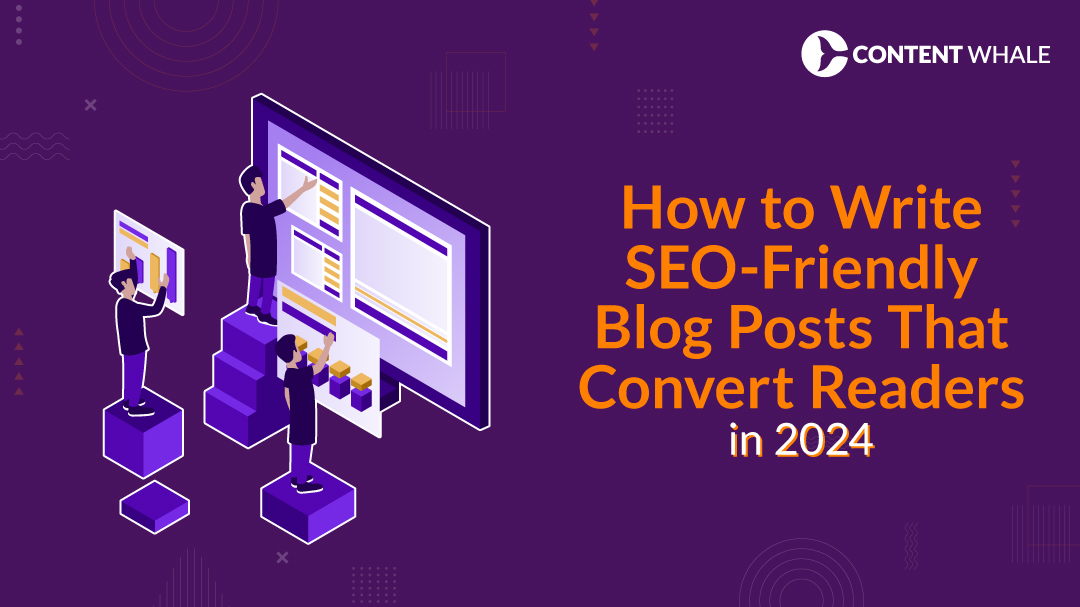Writing SEO-friendly blog posts is one of the best strategies to attract organic traffic and convert readers into loyal customers in 2024. With Google’s continuous updates to its algorithms, staying on top of the latest SEO best practices is essential.
Whether you’re new to SEO blog writing or an experienced content creator, crafting high-conversion blogs requires a fine balance of relevant content and effective content optimization.
From performing keyword research to writing persuasive meta descriptions, this guide will walk you through simple yet powerful blog SEO techniques that will not only help your content rank higher but also engage your audience and boost your click-through rates.
Get ready to learn how to structure your posts, use internal linking, and stay ahead of the competition in 2024.
1. Understanding the Importance of SEO in 2024
As search engines evolve, SEO-friendly blog posts are no longer just about keyword stuffing or basic optimization. In 2024, a winning SEO strategy must focus on user intent and creating valuable, optimized blog content that ranks and converts. Here are the key factors that make SEO crucial this year:
A) Impact on Rankings and Visibility
- Google algorithms now prioritize delivering the most relevant results based on user needs. This means your content must be tailored to search intent.
- By aligning your blog content with what users are searching for, you increase your chances of appearing higher on the SERP rankings and driving organic traffic to your site.
B) User Experience is Key
- Google’s Core Web Vitals are essential SEO metrics that measure user experience, focusing on page speed, interactivity, and layout stability. Websites that optimize these factors see higher engagement and ranking.
- In addition, mobile-first indexing ensures that websites optimized for mobile devices perform better on search engines. Having a mobile-friendly site is non-negotiable in 2024.
C) Content Freshness
- Keeping your blog posts up to date is another way to boost SEO. Updating old content ensures it remains relevant, addresses current trends, and aligns with the latest SEO best practices.
- Refreshing content also improves its chance to rank again, as search engines prefer sites with regularly updated, optimized blog content.
D) Better Click-Through Rates (CTR)
- SEO helps drive higher click-through rates by ensuring your content ranks prominently. The higher you rank, the more likely users are to click on your post, improving traffic and conversions.
| # | SEO Importance in 2024 | Details | Benefits |
| 1 | Increased Online Competition | SEO helps businesses stand out in a crowded digital space. | Increases visibility and traffic. |
| 2 | User Experience (UX) Focus | Optimizing for Core Web Vitals improves site speed and responsiveness. | Enhances rankings and user engagement. |
| 3 | Evolving Search Intent | Aligning content with search intent is crucial. | Boosts relevance, rankings, and traffic. |
| 4 | Mobile-First Indexing | Google prioritizes mobile-friendly sites. | Improves mobile search rankings. |
| 5 | Voice Search Optimization | Growing voice search demands conversational keywords. | Captures voice search traffic. |
| 6 | AI and Machine Learning | AI tools streamline SEO tasks and optimize content. | Improves strategy and efficiency. |
| 7 | Quality Content | High-quality content is still key to rankings. | Builds credibility and boosts rankings. |
| 8 | Local SEO for Businesses | Optimizing for local searches increases visibility. | Drives local traffic and trust. |
| 9 | Backlinks and Domain Authority | High-quality backlinks boost site authority. | Improves rankings and trustworthiness. |
2. Keyword Research: Finding the Right Words to Target

Effective keyword research remains at the core of creating SEO-friendly blog posts that attract the right audience and drive conversions. In 2024, tools and strategies for keyword research have become more sophisticated, allowing content creators to uncover valuable insights into search behavior and search intent.
A) Use Advanced Tools
Leverage tools like SEMrush, Ahrefs, and Google Keyword Planner to find high-value keywords. These tools provide metrics such as search volume, competition level, and keyword difficulty to help prioritize keywords that are both relevant and achievable for your content. Long-tail keywords are particularly valuable because they often reflect specific user queries, making them excellent for driving high-conversion blogs.
B) Focus on Search Intent
Categorizing keywords based on search intent—whether informational, transactional, or navigational—ensures that your content matches what users are looking for. This alignment between content and intent is key to increasing click-through rates and engagement.
C) Competitor Analysis
Analyzing competitor keywords through tools like SpyFu or Moz Keyword Explorer can reveal gaps in your strategy and help you identify untapped opportunities. By targeting keywords that your competitors rank for, you can gain valuable insights into successful blog SEO techniques.
D) Avoid Keyword Stuffing
While content optimization is important, overloading your post with keywords can harm readability and SEO performance. Focus on integrating LSI keywords naturally into your blog content to maintain a balance between relevance and readability.
| # | Steps | Description | Benefits |
| 1 | Brainstorm Seed Keywords | Identify core topics related to your business or niche. | Helps start with relevant keyword ideas. |
| 2 | Use Research Tools | Utilize tools like Google Keyword Planner and SEMrush to find keywords. | Provides insights into search volume and competition. |
| 3 | Analyze Volume & Competition | Focus on keywords with good search volume and manageable competition. | Balances traffic potential and ranking difficulty. |
| 4 | Consider User Intent | Ensure keywords match what users are looking for (informational, etc.). | Aligns content with user needs, boosting relevance. |
| 5 | Focus on Long-Tail Keywords | Target specific long-tail keywords. | Easier to rank for, with higher conversion potential. |
| 6 | Group & Prioritize | Organize keywords by themes and prioritize based on business goals. | Streamlines content creation around key themes. |
| 7 | Monitor & Update | Continuously track keyword performance and trends. | Keeps your strategy fresh and optimized for changes. |
3. Structuring Your Blog Post for SEO Success
A well-structured blog post is key to ensuring both readability and SEO performance. Using H1, H2, and H3 tags effectively organizes your content for search engine optimization while improving user experience.
A) The Role of Headings (H1, H2, H3)
- H1 Tag: This is your blog post’s main title and should contain your primary keyword, like “SEO-Friendly Blog Posts.” It tells both readers and search engines what your post is about.
- H2 Tags: These subheadings break your content into digestible sections. Include secondary keywords like “SEO blog writing” or “content optimization” to guide search engines through the blog.
- H3 Tags: These are used for subsections under H2s, providing even more structure. They are ideal for breaking down complex ideas and making your blog more skimmable.
B) Improving Readability with Subheadings
- Subheadings make your content more accessible and easier to scan. Readers can quickly locate the information they’re looking for without wading through large blocks of text.
- Use descriptive, keyword-rich subheadings to improve SEO while keeping your content organized.
C) Writing Engaging Introductions and Conclusions
- Introductions should capture attention immediately and highlight your main points, while also featuring your primary keyword early on.
- A well-structured conclusion reinforces the key takeaways and encourages user engagement, boosting click-through rates and conversions.
D) Enhancing Readability with Short Paragraphs and Bullet Points
- Keep paragraphs short, ideally two to three sentences. Bullet points and lists break down complex information and increase user retention, improving the overall SEO ranking factors.
4. Writing Meta Descriptions That Convert

A well-crafted meta description can significantly improve click-through rates (CTR) and help your blog post stand out in search results. While meta descriptions don’t directly impact your ranking, they play a crucial role in influencing whether users click on your link.
A) Include Primary Keywords and Secondary Keywords
Using primary keywords like “SEO-Friendly Blog Posts” in your meta descriptions is essential, but it’s also important to incorporate relevant secondary keywords like “SEO blog writing” and “content optimization.” This helps search engines understand the context and increases the likelihood that your description will appear in the search results.
B) Be Concise but Compelling
Keep your meta descriptions under 155 characters to ensure they don’t get cut off in the search results. Clearly communicate the benefit of clicking on your blog post, and use action-oriented language to encourage users to explore further. Adding phrases like “learn how to create high-conversion blogs” can prompt readers to engage.
C) Use a Call-to-Action (CTA)
Incorporating a call-to-action (CTA) like “Get started today!” or “Find out more” helps to drive user engagement. Meta descriptions that include a CTA often result in higher CTRs as they create a sense of urgency and direct users toward action.
On-Page SEO Optimization Tips
Optimizing your blog post for on-page SEO is essential to ensure that search engines understand your content and users have a positive experience. Here are some of the best practices for 2024:
A) Internal and External Linking
Internal links help distribute SEO equity across your site, guiding users and search engines through your content. For example, linking relevant pages together improves web traffic growth and helps search engines discover and understand the structure of your site. Make sure that your internal links use descriptive anchor text and avoid generic phrases like “click here.” External links, on the other hand, build credibility by connecting to authoritative sources.
B) Optimizing Images with ALT Text
Including ALT text for images is a vital part of on-page SEO. ALT text not only improves accessibility for users with screen readers but also helps search engines index your images. Use primary and secondary keywords in ALT text where appropriate, without stuffing. Additionally, ensure that your images are compressed and use proper formats like WebP to improve page load speed, which is crucial for mobile-friendly content.
C) Mobile-Friendly and Fast-Loading Content
With the shift to mobile-first indexing, ensuring your blog is optimized for mobile devices is more important than ever. Implement a responsive design, optimize your page speed by compressing files, and use lazy loading for images and videos to ensure that content loads quickly, reducing bounce rates and improving user experience. Google considers page speed a ranking factor, so keep your site fast.
5. Keeping Content Fresh: The Power of Updates
Keeping your blog posts updated is crucial for maintaining content freshness and optimizing your site for SEO. Here are key reasons and actionable tips to ensure your content stays relevant:
A) Why Content Freshness Matters
- Improves SEO: Search engines, especially Google, prefer up-to-date content that aligns with the latest search intent and trends.
- Increases Authority: Regular updates signal to search engines and users that your site is a reliable and current source of information. This can enhance your site’s credibility and SERP ranking.
- Boosts Engagement: Fresh, relevant content is more likely to engage users and increase click-through rates, which leads to better web traffic growth.
B) How to Keep Your Content Fresh
- Conduct Regular Audits: Review your content every 6-12 months. Identify key pages that drive organic traffic and update them with new data, statistics, and insights.
- Enhance Readability: Revise the structure of your posts by adding updated internal linking, improving blog structure, and making it more visually appealing.
- Optimize for SEO: Update keywords, add relevant LSI keywords, and ensure your content aligns with current on-page SEO standards.
C) Practical Tips for Updates
- Incorporate New Information: Add recent statistics, case studies, or new developments in your industry to keep your SEO-friendly blog posts relevant.
- Update Visuals: Optimize images with fresh, engaging visuals and updated ALT text to enhance both user experience and SEO.
- Repurpose Content: Consider transforming old posts into new formats like infographics, videos, or podcasts to reach different audiences and extend the lifespan of your content.
Conclusion

Writing SEO-friendly blog posts that effectively convert readers in 2024 requires a blend of technical optimization and engaging content. By focusing on thorough keyword research, structuring your posts with clear headings and subheadings, and incorporating meta descriptions that encourage clicks, you can significantly boost your blog’s performance.
Moreover, the success of your SEO blog writing depends on continuously updating your content to keep it relevant and aligned with changing search intent. This approach ensures that your blog remains valuable, maintains content freshness, and performs well in search engine rankings.
Remember, SEO is not just about driving traffic—it’s about turning that traffic into meaningful engagement and conversions. If you’re looking to elevate your content strategy, let us help you create optimized, high-conversion blogs that resonate with your audience and achieve your business goals.
At Content Whale, we craft SEO-friendly blog posts designed to rank well and drive conversions. Our expertise includes content optimization, keyword integration, and on-page SEO, ensuring your content is always fresh and aligned with search intent. Let us help you boost your traffic and engagement effortlessly.
FAQs
1. What is the best length for an SEO-friendly blog post?
The ideal blog post length varies depending on your target audience and niche, but in general, posts that are between 1,500 to 2,500 words perform best. Long-form content allows you to cover a topic in-depth, which is valued by search engines like Google for ranking purposes. However, it’s important to maintain a balance between length and quality—engaging, readable content that addresses search intent will always outrank longer, less valuable posts.
2. How many keywords should I use in a blog post?
It’s recommended to aim for a keyword density of 0.5% to 1% of the total word count for your primary keyword. Additionally, you should naturally incorporate secondary keywords and LSI (Latent Semantic Indexing) keywords to help search engines better understand your content’s relevance. Overstuffing keywords can harm both readability and SEO, so focus on a natural flow that addresses user needs while integrating keywords effectively.
3. How often should I update my blog posts?
Regular updates are essential for keeping your content relevant. As a rule of thumb, reviewing and updating your content every 6 to 12 months helps maintain its freshness, align it with current SEO best practices, and keep it relevant to changing search intent. Prioritize high-performing, evergreen posts for updates, adding new information, visuals, or restructuring the content where needed.
4. What are meta descriptions, and why are they important?
A meta description is a short summary of your blog post that appears in search engine results. While it does not directly affect rankings, a well-crafted meta description can significantly improve click-through rates (CTR) by enticing users to click on your link. Meta descriptions should be 155-160 characters, include your primary keyword, and use a call-to-action (CTA) to encourage users to engage with your content.
5. How do internal and external links improve SEO?
Internal links help distribute SEO value across your site and guide users to more of your content, which can improve user experience and dwell time. On the other hand, external links to authoritative sources enhance the credibility of your post and signal to search engines that your content is well-researched. Both types of links are essential to a well-rounded SEO strategy that boosts ranking and engagement.





